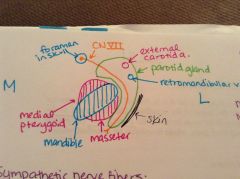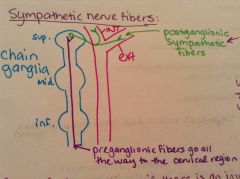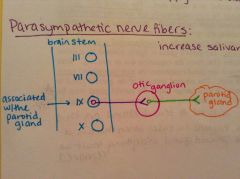![]()
![]()
![]()
Use LEFT and RIGHT arrow keys to navigate between flashcards;
Use UP and DOWN arrow keys to flip the card;
H to show hint;
A reads text to speech;
23 Cards in this Set
- Front
- Back
|
What is the parotid gland?
|
The parotid gland is the largest of the salivary glands. It occupies a 3D space called the parotid bed, just beneath the skin in front of the ear.
|
|
|
What is the parotid region?
|
A bony, muscular and fascial-lined space beneath the skin in front of the ear.
|
|
|
What are the boundaries of the parotid region?
|

Posterior - mastoid process
Medial - styloid process Anterior - medial pterygoid and masseter muscles |
|
|
What are the contents of the parotid region?
|
-parotid gland
-external carotid a. and several of its branches -external jugular v. and several of its tributaries -parts of the facial nerve (CN VII) -parts of the trigeminal nerve (CN V) |
|
|
What are the two parts of the parotid gland?
|
-superficial part
-deep part |
|
|
What divides the parotid gland in two?
|
The dividing line b/t the deep and superficial parts is indicated by the position of the facial nerve and its terminal branches.
|
|
|
Describe the superficial part of the parotid gland.
|
Covers most of the masseter and extends anteriorly along the parotid duct.
|
|
|
Describe the deep part of the parotid gland.
|
Conatins the:
-external carotid a. with several of its branches -retromandibular v. and its tributaries -auriculotemporal n. (a branch of CN V, the trigeminal n.) |
|
|
What is the parotid duct?
|
Carries the secretions of the parotid gland, courses superficially over the masseter to pierce the buccinator muscle and open into the vestibule of the oral cavity adjacent to the second upper molar tooth.
|
|
|
How is the production of saliva secretion controlled?
|
By sympathetic and parasympathetic nerve stimulation.
|
|
|
How do sympathetic nerve fibers affect the production of saliva?
|

Stimulation of the parotid gland by sympathetic nerve fibers result in reduced saliva secretion, due to vasoconstriction of the vessels that supply the gland.
|
|
|
What comprises the carotid plexus?
|

Postganglionic nerve fibers.
|
|
|
Where do the postganglionic nerve fibers (of the carotid plexus) go?
|
Everywhere the arteries go.
|
|
|
What if the preganglionic nerve fibers are injured d/t a traumatic event?
|
If they are cut off, then the flow of information through the fibers is cut off and results in no sympathetic nerve supply to one side of the head. (Ex. Horner's syndrome)
|
|
|
What is Horner's syndrome?
|
With Horner's syndrome, the upper eyelid cannot be raised voluntarily. If the cervical sympathetic trunk is interrupted, the superior tarsal muscle is paralyzed, which causes drooping of the eyelid (ptosis). This is a sign of cervical sympathetic trunk injury.
|
|
|
How do parasympathetic nerve fibers affect the production of saliva?
|

Stimulation of the parotid gland by parasympathetic nerve fibers in the glossopharyngeal nerve (CN IX) results in increased salivary production.
|
|
|
What happens if there is edema in the parotid gland?
|
The parotid gland is covered by dense connective tissue that does not allow for much expansion. In cases of viral infections (ex. mumps), edema in the parotid gland compresses the auricultemporal nerve and produces pain.
|
|
|
What happens if there is a tumor of the parotid gland?
|
-If the tumor is benign, it must be carefully removed piece by piece, to avoid the facial nerve
-If the tumor is malignant, it must be completely removed, along with the facial nerve. |
|
|
Bell's palsy (TEST QUESTION!)
|
A form of facial paralysis caused by dysfunction of the facial nerve (CN VII). The condition is usually temporary.
|
|
|
What is the arterial supply of the parotid region?
|
Branches of the:
-posterior auricular a. (behind the ear) -superficial temporal a. (can feel a pulse in this artery) -transverse facial a. (crosses the face) |
|
|
What is the veinous drainage of the parotid region?
|
The retromandibular vein.
|
|
|
Describe the lympathic drainage of the parotid region?
|
Drainage goes to two groups of cervical lymph nodes:
-Superficial cervical lymph nodes (adjacent to the external jugular vein) -Deep cervical lymph nodes (adjacent to the internal jugular vein) |
|
|
What innervates the parotid region?
|
-great auricular nerve (a branch of the cervical plexus)
-auriculotemporal nerve (a branch of the trigeminal nerve CN V) |

